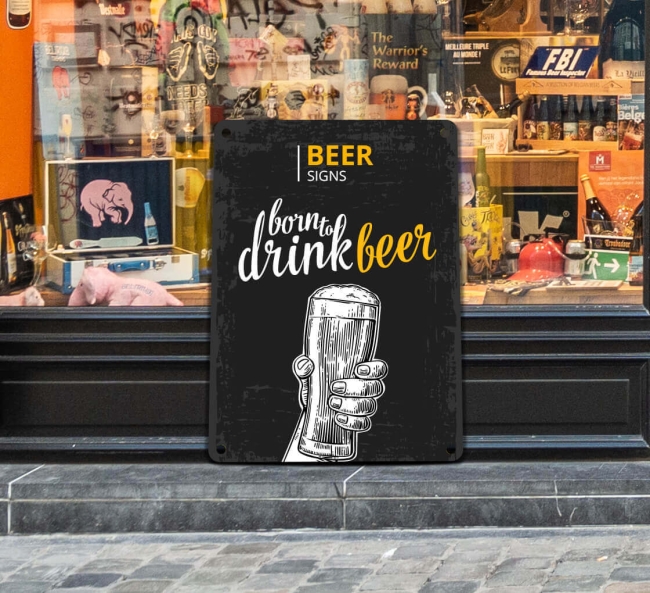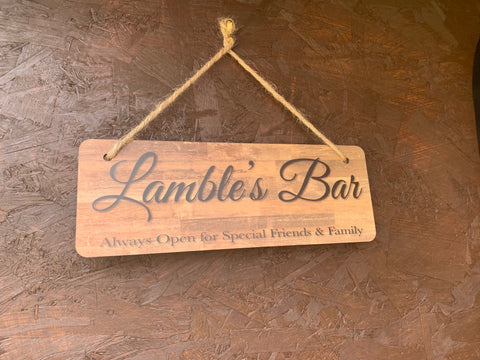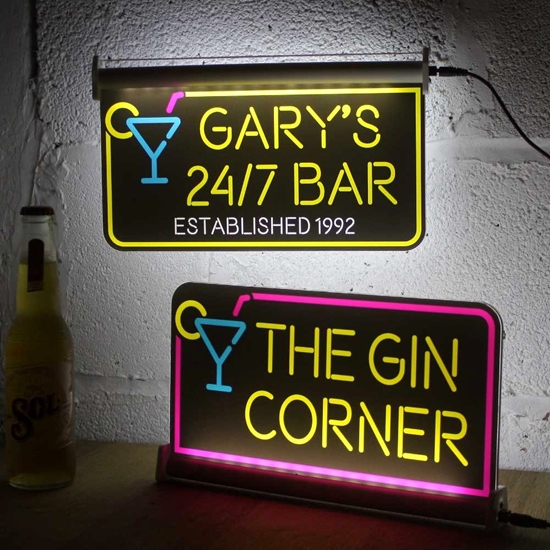Recommended Ideas For Selecting Bar Signs
Recommended Ideas For Selecting Bar Signs
Blog Article
What Is The Difference Between Bar Signs In Terms Of Material?
The materials used to make bar signs are very different. Each one has its particular advantages and features which can be customized to fit various aesthetics and purposes. The following is a comparison of materials commonly used for bar signs and the differences between them: Wood
Characteristics: Natural, rustic, warm.
Durability The material is usually durable, however it can be affected by humidity or need maintenance.
Uses: Perfect for rustic or vintage-themed bars customized name signs and menu boards.
Customization: Can be carved, painted or stained. Easily customizable with various finishes.
2. Metal
Characteristics: Sleek, modern, industrial.
Durability. Extremely durable. It can be used outdoors or indoors.
Ideal for branding signs and robust informational signage.
Customization - It can be laser cut, painted, embossed or embossed. Often used for intricate logos and designs.
3. Neon
Characteristics: Bright, eye-catching, retro.
The durability of a product is an issue. It's possible to be brittle, but if it's maintained correctly, it'll last for a long time.
Uses: Great for bright attractive signs, attracting attention, branding, and creating an ambiance that is retro.
Customization limited to outline shapes or text due the nature of neon tube. Available in various colors.
4. You can also find out more about Acrylic
Characteristics: Versatile, lightweight, modern.
Durability Long-lasting and resistant to and resistant to fading. Ideal for indoor use.
Uses : For modern and elegant signs. Also great for signs that are illuminated.
Customization: Laser cut, be printed or layered in a three-dimensional effect. Available in a variety of colors and finishes.
5. Vinyl
Specifications: Easy to use, adaptable, and adaptable.
Durability - Ideal for semi-permanent and temporary uses. Vinyl that is of the highest quality can be used to last outdoors.
Uses: Perfect to use for window graphics, promotions that are temporary and decals that are custom-designed.
Customization: Highly customizable with printed designs, cut-out shapes and a variety of colors. Easy to apply and remove.
6. Chalkboard
Characteristics: Functional, rustic, interactive.
Long-term durability - Regular maintenance (cleaning and replacing chalk). Not properly maintained the chalk could be damaged.
Uses include menu boards with daily specials as well as interactive signs in locations where information changes often.
The possibility of customization is available through the addition of handwritten notes or designs as well as other information. For extra durability, you may choose to frame your artwork using different materials.
7. Glass
Characteristics: Elegant, sleek, modern.
Durability: The material is fragile however it can be made to last by tempering. Often used with backlighting for an enhanced appearance.
Signage uses include high-end signs to promote branding, illuminated signboards and window graphics.
Customizations: They can be painted, printed, or etched. When combined with lighting to create an impressive look.
8. PVC
Characteristics: Lightweight, versatile, cost-effective.
Durability Sturdy and resistant to weather, ideal for indoor or outdoor use.
It is used for temporary signage at events, light branding, and event promotions.
Customization is possible: Print, paint, and cut into a variety of shapes. Available in different thicknesses.
9. LED
Characteristics: Energy-efficient, bright, modern.
Durability - Very durable and long-lasting. Perfect for use over the course of time.
Uses: Great for creating dynamic lighting effects, illuminated signs, and modern branding.
Customization available in various colors with the ability to program animations and messages.
10. Foam Board
Lightweight, affordable and simple to use.
Durability : Less durable. Recommended for temporary indoor uses.
Ideal for temporary advertising, exhibitions and informational signs.
It is possible to customize your print or applying vinyl. Cut easily into various shapes.
The bar sign material has unique properties that influence its appearance, durability, and suitability in various settings. The material you choose to use will depend on the purpose of usage, budget, and aesthetic requirements. Have a look at the top rated discover more for personalised pub signs for more info including cocktail bar sign, to the bar sign, large pub sign, design your own bar sign, garden bar sign personalised, personalised signs for bar, to the pub sign, pub signs for garden, pub bar signs for sale, personalised pub signs for garden and more.
How Can The Reading Ability Of Bar Signs Vary?
The ability to read bar signs is affected by several factors, including the font size, font as well as contrast in color lighting and placement. This article will provide a thorough review of how these variables influence the readability of bar signs:1. Font Choice
Significance: The font is used to create the sign.
Simple serif or sans-serif fonts like Arial and Helvetica.
Stylized Text: decorative or script fonts particularly when seen from a distance or in low lighting conditions they can make it difficult to see the text.
Impact: Clear, easily readable fonts enable patrons to easily and quickly understand the information.
2. Font Size
The sign's characteristics include: Size of the text.
Large Fonts: Readable at a distance. ideal for exterior and main signs.
Small fonts are suitable for close-up viewing, such as menus or tabletop signage.
Impact: Choosing the right size of font will make it simpler to read text at various distances.
3. Color Contrast
Characteristics: Difference in color between background and text.
High contrast: Text with a dark background or text that has an unlit background.
Low Contrast: Background and text similar colors can make it difficult to read text (e.g. grey on black).
The impact: A high contrast enhances readability by ensuring that text is clearly visible.
4. Lighting
Signs' characteristics: how the sign is lit.
Well-lit signs: Signs that are front or back lit enhance visibility in dim light conditions.
Signs with poor lighting Poorly lit signs can be difficult for people to read in dim lighting or at night.
The impact of light is that all signs, especially in dark locations can be seen.
5. Material and Finish
Signs can be distinguished by the type of material used and the final appearance.
Matte Finish helps reduce glares and reflections making text easier for you to read.
Glare on a Glossy Surface: This can be a problem particularly when it is in direct sunlight. It can also can hinder reading.
Impact: By minimizing reflections, reflections, and glare, the appropriate finish and material can enhance the readability of your display.
6. Text Layout
Characteristics: the arrangement of text within the sign.
Clear Hierarchy. Use subheadings to group data.
Signs with a cluttered layouts are difficult to read.
Impact An organized and clear layout will help patrons find the information they need quickly.
7. Viewing Distance
Characteristics The distance from where the sign is intended to be read.
For long distance: larger font and high contrast are vital.
Short Distance: Although smaller text is acceptable, clarity and simplicity are still important.
Signs that impact the environment must be designed to accommodate the distance at which they will be viewed.
8. Placement
The location of the sign inside the bar.
The best position is at eye level, unobstructed, and in well-lit areas.
Poor placement: high up, blocked by objects or in areas that have inadequate lighting.
Impact: The placement of signs makes them easy to read by patrons.
Signs with Readable Text Examples
Exterior Signs
Characteristics Specifications: Large text High contrast, well-lit (e.g., backlit or neon), placed prominently.
Effect: Attracts customers by drawing interest.
Menu Boards
Specifications include clear headings, and large text for the names of the items.
Effect: It's simpler for customers to make a decision and review their orders. Customers will experience more enjoyable experience.
Directional Signs
They are characterized by simple arrows as well as clear, large text.
Impact Effect: Increases general flow, satisfaction and ability of patrons to easily navigate.
Promotional Signs
Characteristics: Bold text to promote advertising High contrast, well-lit, positioned in areas with high traffic.
Impact: Promotes customer engagement by effectively communicating special promotions and events.
Factors Affecting Readability
Environment: Ambient lighting and the general atmosphere of a bar could influence how the signs are read. Signs' ability to be read is enhanced in well-lit, bright environments.
Patron movement Bars which are busy the signage must be easily read by patrons who are on the move. It is important to make use of large, high-contrast text in these situations.
When updating signs, it's essential to choose a format that are easily read and are updated frequently (e.g. digital displays or chalkboards).
By focusing attention on these elements the bar's owners will be able to make sure their signage doesn't just appear attractive, but are also easily readable. This improves overall customer experience. View the recommended helpful resource on pub bar signs for more tips including bar sign outdoor, design a pub sign, bespoke bar signs, pub signs for garden bar, to the pub sign, buy bar signs, hanging pub signs personalised, sign for garden bar, hanging home bar signs, garden bar signs and more.
What Is The Difference Between The Bar Signs That Are In Regulations And Other Bar Signs?
There are a variety of rules and regulations applicable to bar signs. These include local, state and federal laws that ensure public safety and aesthetic standards. These are the main distinctions between bar signs and their rules. There are rules regarding the size and location of signs.
Zoning law: It is a set of regulations that determine where signs may go in relation to their size, height and distances from the property line, road or other nearby structures.
Historical Districts. Signs of any size or designs and materials can be banned to protect the historical character.
2. Illumination Restrictions
Light Pollution Regulations could limit the brightness and color of illuminated signs to protect the atmosphere at night and limit light pollution.
Safety considerations: Signs shouldn't cause glare that could distract drivers and pedestrians.
3. Signage Content
Alcohol Advertising: Alcohol advertisements are banned in certain states. They ban images or other content that could appeal to minors or promote excessive drinking.
Health Warns. The law may require warning signs that warn of the dangers of smoking cigarettes or alcohol consumption.
4. Historic Preservation Regulations
Architectural Compatibility Signs must match the style and character in the historical district. This often requires approval by preservation boards or commissions.
Materials and Design Limitations may apply to the materials, design, and color scheme of signs to ensure the integrity of the past.
5. Sign Permitting Process
Permit requirements: Before putting up or changing the signs bars are required to obtain permits. This might require the submission of plans, payment of fees and obtaining approval from local authorities.
Code Compliance: Signs need to be in compliance with the building codes as well as fire safety rules as and accessibility standards to ensure public safety and to ensure accessibility for those who are disabled.
6. Sign Removal and Maintenance
Maintenance requirements: It is the responsibility of bar owners to keep their signage in good working order. This includes ensuring they're safe, structurally sound and conform to all laws.
Abandoned Signs: Regulations may be in place to remove signs that are abandoned or damaged to prevent blight and maintain the beauty of the location.
7. Digital Signage Regulations
Content Restrictions There are laws in place that regulate the content of digital signs. They could prohibit certain types of content, like pictures that are offensive or lights that flash.
Limitations on operation: Regulations may restrict the intensity, speed or frequency at which digital signs change to minimize visual noise.
8. Penalties and Enforcement
Inspections. Local authorities perform periodic inspections of signs to ensure the compliance. For violations, citations are issued.
Penalties - Penalties could include fines or court orders, requests for signs to be removed or modified, and legal action.
9. Sign Process
Variance Applications: Bar owners can request variances in order to differ from standard signage regulations providing a reason for the variance, and minimizing any adverse effects on public safety or aesthetics.
Public Input : Disagreements may be a cause for hearings in the community or input by business associations or property owners.
10. Participation and Engagement of the Community
Public Consultation: Some authorities involve local residents in the development of regulations for signage through public meetings, surveys, or stakeholder meetings.
Community Benefits: Sign regulations can contain provisions to improve the appearance of signs or promote local businesses or contribute to neighborhood revitalization initiatives.
If they adhere to and understand the guidelines for signs Bar owners can ensure that their signage adds an aesthetic appeal to their establishments, make a positive contribution to the local community, and are in compliance with the legal standards. This helps reduce the chance of legal battles, fines or penalties. Read the best this hyperlink for blog examples including pub bar signs, bar sign hanging, bar signs, bar sign hanging, personalised garden bar signs, home garden bar signs, personalised bar signs, personalised cocktail bar sign, bespoke bar signs, large pub sign and more.